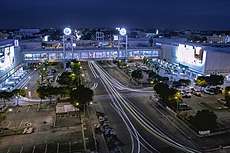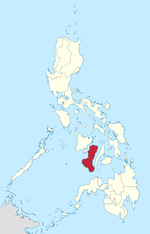Negros Island Region
The Negros Island Region (Hiligaynon: Rehiyon sang Pulo sang Negros; Cebuano: Rehiyon sa Pulo sa Negros), also abbreviated and officially designated as NIR (unofficially Region XVIII), was a short-lived administrative region in the Philippines which comprised the provinces of Negros Occidental and Negros Oriental, both of which are part of the island of Negros. A reincarnation of the earlier Republic of Negros, it existed from May 29, 2015 to August 9, 2017. Local officials[2] and the Consultative Committee to Review the 1987 Constitution have proposed to reinstate Negros as a region or state of a Philippine federation.[3]
| Negros Island Region (NIR) | |||||||||||||
|---|---|---|---|---|---|---|---|---|---|---|---|---|---|
| Former region of the Philippines | |||||||||||||
| 2015–2017 | |||||||||||||
 Location within the Philippines | |||||||||||||
| Capital | Bacolod and Dumaguete (interim joint temporary regional centers for a three-year transition period; Kabankalan and neighboring Mabinay were to be joint permanent regional centers) | ||||||||||||
| Population | |||||||||||||
• 2015[1] | 4,414,131 | ||||||||||||
| History | |||||||||||||
• Established | May 29 2015 | ||||||||||||
• Disestablished | August 9 2017 | ||||||||||||
| Political subdivisions | 2 provinces
| ||||||||||||
| |||||||||||||
| Today part of | |||||||||||||
History
The Negros Region was rooted firmly in the sovereign Republic of Negros, declared by Negrese revolutionaries on 5 November 1898 but later annexed by the United States to the Philippines on 30 April 1901.[4]
Early initiatives
The movement for a single-island region started in the 1980s when officials of both provinces proposed a one-island, one-region unit. At the time, Negros Occidental and Negros Oriental were the only provinces in the Philippines situated on the same island but belonging to two different administrative regions with regional offices located in neighboring Panay and Cebu respectively. This led to the filing of House of Representatives Bill No. 1477 titled "An Act Merging the Province of Negros Occidental and Oriental into One-Island Region." They argued, among others, that the two provinces "nestle in one common island; have common fowls and beasts in the forest; share the same soil in our plains and mountains; benefit and suffer together from the rivers that snake through our land; and our ancestors roamed the same length and breadth without complications of political, social, economic, religious and lingual obstacles."
The proposal was continued through talks between former Governor Bitay Lacson of Negros Occidental and the late former Governor Emilio Macias of Negros Oriental in 1990. Their successors, former Governor Rafael Coscolluella and former Governor (now Representative) George Arnaiz took the initiative further, first identifying Kabankalan in Negros Occidental and the neighboring municipality of Mabinay in Negros Oriental, with the two situated on or near the geographic center of the island, as joint regional centers. However, the National Economic and Development Authority (NEDA) turned down the proposal for lack of funds to effect the merger.[5]
Revival of proposal
In 2013, the one-island region talks were continued by Negros Oriental Representatives Pryde Henry Teves and George Arnaiz, and Negros Occidental Governor Alfredo Marañon Jr. with Representative Alfredo Marañon III and Coscolluela.[6] They pointed out that, while the creation of a new region would entail substantial costs to the government, it would be advantageous to the people of both provinces because they would not need to travel by sea any more to process transactions in the regional offices.[7] They also claimed that a one-island region would also result in better coordination between both provinces in tourism, peace and order, environment, development planning, disaster management, and road infrastructure. Edward Du, president of the Negros Oriental Chamber of Commerce and Industry, also proposed to convert existing offices of national agencies in the provincial capitals of Bacolod and Dumaguete to sub-regional offices during an interim period if the proposal was approved to defray the costs of establishing a new regional center. Various public officials and representatives from academic, religious, media, and other private sectors aired support for the proposal.[8][9]
Notably, Negros Oriental Governor Roel Degamo was tagged as being initially opposed to the talks, claiming he was not convinced with a one-island region setup and that his constituents were allegedly not in favor of its creation.[10] He eventually clarified that his original stand as regards the region was being "open" to it and that there were some concerns, such as revenue sharing between the two provinces, that had to be thrashed out first.[11]
President Benigno Aquino III directed the Department of the Interior and Local Government (DILG) to study the establishment of a new region.[12] The DILG subsequently endorsed the proposal, noting that the new region would mean integrated planning for holistic development, disaster management, tourism promotion, and peace and order management.[13] NEDA affirmed by saying that its studies show that the proposed region is economically viable.[14]
Establishment
On May 29, 2015, President Aquino signed Executive Order 183,[15] joining the twin Negros provinces into one region — the Negros Island Region. It separated Negros Occidental and its capital Bacolod from Western Visayas (Region VI) and Negros Oriental from Central Visayas (Region VII), raising the total number of regions of the Philippines to 18.[16][17][17]
Dissolution and future
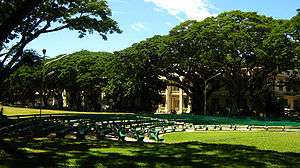
On August 9, 2017, President Duterte signed Executive Order No. 38, finally revoking the Executive Order No. 183 signed by former President Benigno Aquino III in 2015. The official reason given by Secretary of Budget and Management Benjamín Diokno was the lack of funds needed to fully establish Negros as a functioning region. Earlier, Diokno had notably been dismissive of the region's continued existence, being quoted as saying, "Well, you don't want to spend ₱19 billion for such [a] two-province region. In any event, [even] with ... federalism, that region will not be created [as it would seem] useless."[18]
Its dissolution upset the NIR regional officials and saddened Negrenses.[19] However, many Negrense politicians are pushing for a "Negros Federal State", and are exploring the possibility of creating a Negros Development Alliance.[20] Due to the rise of the Philippine government's conversion into federalism under President Rodrigo Duterte, Negros Island Region may have had the capability to become a separate federal state.[21][22] There have also been proposals by House of Representatives Speaker Pantaleón Álvarez to move some governmental offices to the Negros Region from Metro Manila, once the nation transitions into the federal government, due to the island's strategic location between Luzon and Mindanao, as well as its vast areas which could accommodate the government offices to be built in there. However, Álvarez' proposal has not yet been approved by the majority of PDP-Laban members and its chairman, Koko Pimentel. Technicalities prevent Pimentel from approving the proposal as the region had already been abolished by Duterte in 2017.[23][24][25]
To address the quantitative concerns of those who frown upon the existence of a two-province region, the reintegration of Siquijor, currently part of Central Visayas, into historical Negros had been floated as an idea by then-Interior Secretary Mar Roxas on his visits to both Negros Occidental and Negros Oriental. On average, it takes five hours to reach the regional offices located in Cebú, while only an hour to get to Dumaguete in Negros Oriental. Siquijor used to be a part and later on a sub-province of Negros Oriental, finally splitting off from it on 17 September 1971.[26]
To date, there also exists an informal proposal for a Cebuano Visayan State ruled under a common federal government. The ethnic and territorial claims of the proposed region, however, overlap with those of Negros, whether as a former sovereign republic or a Philippine subdivision, and Bohol, whose Cebuan-speaking natives nonetheless identify as a distinct people.
Administrative divisions
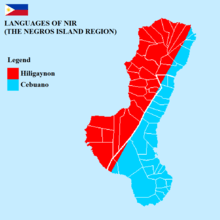
The Negros Island Region was composed of two provinces, one highly urbanized city, 18 component cities, 38 municipalities, and 1,219 barangays.
| Province or HUC | Capital | Population (2015)[27] | Area[28] | Density | Cities | Muni. | Bgy. | ||||||
|---|---|---|---|---|---|---|---|---|---|---|---|---|---|
| km2 | sq mi | /km2 | /sq mi | ||||||||||
| Negros Occidental | Bacolod | 56.6% | 2,497,261 | 7,802.54 | 3,012.58 | 320 | 830 | 12 | 19 | 601 | |||
| Negros Oriental | Dumaguete | 30.7% | 1,354,995 | 5,385.53 | 2,079.36 | 250 | 650 | 6 | 19 | 557 | |||
| Bacolod | † | — | 12.7% | 561,875 | 162.67 | 62.81 | 3,500 | 9,100 | — | — | 61 | ||
| Total | 4,414,131 | 13,350.74 | 5,154.75 | 330 | 850 | 19 | 38 | 1,219 | |||||
|
† Bacolod is a highly-urbanized city; figures are excluded from Negros Occidental. | |||||||||||||
At the time of its existence, the Negros Island Region had the fewest provinces in the Philippines (only two), but had 19 cities (18 component cities and the highly urbanized city of Bacolod) in total, making it the region with the most cities amongst the Visayas regions, tying alongside Calabarzon in Luzon, which also has 19 cities. Bacolod was the most populous city of the region and the center of the Bacolod Metropolitan Area (which also contains the cities of Talisay and Silay), as well as the 19th most populous city of the whole Philippines, while Dumaguete was the most densely populated city in the whole region.
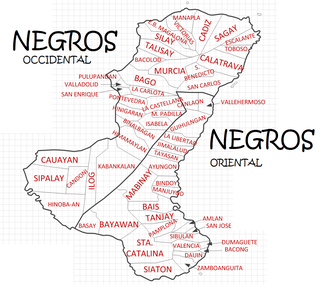
Negros Occidental has the most chartered cities amongst all the provinces in the Philippines. The province comprises 13 cities and 19 municipalities, which are further subdivided into 601 barangays. Although Bacolod serves as the capital, it is governed independently from its corresponding province as a highly urbanized city. Negros Oriental comprises 6 cities and 19 municipalities, with 557 barangays.
| City | Population (2015)[27] | Area[29] | Density | City class | Income class | Province | ||
|---|---|---|---|---|---|---|---|---|
| km2 | sq mi | /km2 | /sq mi | |||||
| Bacolod | 561,875 | 162.67 | 62.81 | 3,500 | 9,100 | Highly urbanized | 1st | Negros Occidental |
| Bago | 170,981 | 401.20 | 154.90 | 430 | 1,100 | Component | 2nd | Negros Occidental |
| Bais | 76,291 | 319.64 | 123.41 | 240 | 620 | Component | 3rd | Negros Oriental |
| Bayawan | 117,900 | 699.08 | 269.92 | 170 | 440 | Component | 2nd | Negros Oriental |
| Cadiz | 154,723 | 524.57 | 202.54 | 290 | 750 | Component | 2nd | Negros Occidental |
| Canlaon | 54,509 | 170.93 | 66.00 | 320 | 830 | Component | 4th | Negros Oriental |
| Dumaguete | 131,377 | 33.62 | 12.98 | 3,900 | 10,000 | Component | 2nd | Negros Oriental |
| Escalante | 94,070 | 192.76 | 74.43 | 490 | 1,300 | Component | 4th | Negros Occidental |
| Guihulngan | 95,969 | 388.56 | 150.02 | 250 | 650 | Component | 5th | Negros Oriental |
| Himamaylan | 106,880 | 367.04 | 141.71 | 290 | 750 | Component | 3rd | Negros Occidental |
| Kabankalan | 181,977 | 697.35 | 269.25 | 260 | 670 | Component | 1st | Negros Occidental |
| La Carlota | 64,469 | 137.29 | 53.01 | 470 | 1,200 | Component | 4th | Negros Occidental |
| Sagay | 146,264 | 330.34 | 127.54 | 440 | 1,100 | Component | 3rd | Negros Occidental |
| San Carlos | 132,536 | 451.50 | 174.33 | 290 | 750 | Component | 2nd | Negros Occidental |
| Silay | 126,930 | 214.80 | 82.93 | 590 | 1,500 | Component | 3rd | Negros Occidental |
| Sipalay | 70,070 | 379.78 | 146.63 | 180 | 470 | Component | 4th | Negros Occidental |
| Talisay | 102,214 | 201.18 | 77.68 | 510 | 1,300 | Component | 4th | Negros Occidental |
| Tanjay | 80,532 | 276.05 | 106.58 | 290 | 750 | Component | 4th | Negros Oriental |
| Victorias | 87,933 | 133.92 | 51.71 | 660 | 1,700 | Component | 4th | Negros Occidental |
References
- Census of Population (2015). Highlights of the Philippine Population 2015 Census of Population. PSA. Retrieved 20 June 2016.
- Gamil, Jaymee T. "Negros leaders push for reconstitution of Negros Island Region". Retrieved 2018-07-24.
- "Con-com proposes to bring back Negros region". GMA News Online. Retrieved 2018-07-24.
- Pacete, Ver F. (November 3, 2016). "Pacete: The fate of the Federal Republic of Negros". Sunstar.
- "What Went Before: A history of splits and mergers". Philippine Daily Inquirer. May 19, 2015. Retrieved June 21, 2015.
- "One-island region for Negros provinces revived". Philippine Daily Inquirer. June 27, 2013. Retrieved June 21, 2015.
- Espina, Marchel P. (April 1, 2014). "Talks on one-island Negros region proposal to resume". The Freeman. The Philippine Star. Retrieved June 21, 2015.
- Gomez, Carla (June 25, 2014). "Island region possible before 2016, Mar says but support data needed". Visayan Daily Star. Retrieved June 21, 2015.
- Bayoran, Gilbert (May 22, 2014). "More support one-island region". Visayan Daily Star. Retrieved June 21, 2015.
- Ellera, Teresa (August 7, 2014). "One regional guv for Negros 'not true'". Sun.Star. Retrieved June 21, 2015.
- Partlow, Judy Flores (May 1, 2015). "On Negros Island Region: Degamo denies saying "yes"". The Freeman. The Philippine Star. Retrieved June 21, 2015.
- "One Negros dream: Aquino won't commit, points to Roxas". Philippine Daily Inquirer. May 27, 2014. Retrieved June 21, 2015.
- Gomez, Carla (January 6, 2015). "PNoy okay of island region seen". Visayan Daily Star. Retrieved June 21, 2015.
- "NEDA: Negros Occ can survive if separated from WV". The Freeman. The Philippine Star. April 19, 2015. Retrieved June 21, 2015.
- "Executive Order No. 183, s. 2015". Official Gazette. Retrieved 12 October 2015.
- "Aquino OKs creation of Negros Island Region". Philippine Daily Inquirer. June 5, 2015. Retrieved June 5, 2015.
- "PNoy joins 2 Negros provinces into one region". ABS-CBNnews.com. June 5, 2015. Retrieved June 21, 2015.
- Ranada, Pia. "Duterte to sign EO dissolving Negros Island Region 'soon' – Diokno". Rappler.
- "Negrenses upset over Duterte's order dissolving Negros region". Sun.Star. August 9, 2017. Retrieved August 9, 2017.
- Bayoran, Gilbert P. (August 18, 2017). "Negros pushed as 'federal state'". The Philippine Star.
- Canet, Carla N. (July 1, 2016). "Negros Island Region can be a federal state — Pimentel". Manila Bulletin. Retrieved July 20, 2016.
- Nicavera, Edwin P. (March 9, 2017). "Negros Island Region state 'inevitable'". Sun.Star. Retrieved March 13, 2017.
- Espina, Marchel P. (November 22, 2016). "Plan to relocate Malacañang to Negros to boost NIR bid". Sun.Star Bacolod. Retrieved August 17, 2017.
- Diaz, Jess (November 20, 2016). "Alvarez: Transfer Malacañang, government offices to Negros". The Philippine Star. Retrieved August 17, 2017.
- Arguillas, Carolyn O. (March 28, 2017). "Alvarez' federal Philippines: 14 states, Negros as seat of central gov't". MindaNews. Retrieved August 17, 2017.
- Espina, Marchel P. (June 13, 2015). "Top Negrense officials split on Siquijor joining Negros Island Region". Rappler. Retrieved June 20, 2015.
- Census of Population (2015). Highlights of the Philippine Population 2015 Census of Population. PSA. Retrieved 20 June 2016.
- "PSGC Interactive; List of Provinces". Philippine Statistics Authority. Retrieved 29 March 2016.
- "PSGC Interactive; List of Cities". Philippine Statistics Authority. Retrieved 29 March 2016.
| Wikimedia Commons has media related to Negros Island Region. |
